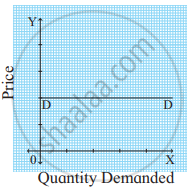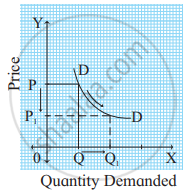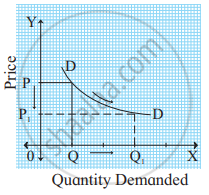Advertisements
Online Mock Tests
Chapters
![Balbharati solutions for Economics [English] 12 Standard HSC chapter 3.2 - Elasticity of Demand Balbharati solutions for Economics [English] 12 Standard HSC chapter 3.2 - Elasticity of Demand - Shaalaa.com](/images/economics-english-12-standard-hsc_6:241bfd6f9011433b9b44c9de23ef18a7.JPG)
Advertisements
Solutions for Chapter 3.2: Elasticity of Demand
Below listed, you can find solutions for Chapter 3.2 of Maharashtra State Board Balbharati for Economics [English] 12 Standard HSC.
Balbharati solutions for Economics [English] 12 Standard HSC 3.2 Elasticity of Demand EXERCISE [Pages 34 - 36]
Complete the following statements:
The price elasticity of demand on a linear demand curve at the X-axis is ______.
zero
one
infinity
less than one
Complete the following statement:
Price elasticity of demand on a linear demand curve at the Y-axis is equal to ________.
zero
one
infinity
greater than one
The demand curve is parallel to the X-axis in the case of ______.
perfectly elastic demand
perfectly inelastic demand
relatively elastic demand
relatively inelastic demand
When the percentage change in quantity demanded is more than the percentage change in price, the demand curve is ______.
flatter
steeper
rectangular
horizontal
Ed = 0 in case of ______.
luxuries
normal goods
necessities
comforts
Give economic term:
Degree of responsiveness of quantity demanded to change in income only.
Give economic terms:
Degree of responsiveness of a change in quantity demanded of one commodity due to a change in the price of another commodity.
Give economic terms:
Degree of responsiveness of a change of quantity demanded of a good to a change in its price.
Give economic term:
Elasticity resulting from infinite change in quantity demanded.
Give an economic term:
Elasticity resulting from a proportionate change in quantity demanded due to a proportionate change in price.
Perfectly elastic demand : Ed = ∞ : : _______ : Ed = 0
Complete the correlation:
Rectangular hyperbola : ______ : Steeper demand curve : Relatively inelastic demand.
Complete the correlation:
Straight-line demand curve : Linear demand curve :: _______ : non-linear demand curve.
Complete the correlation:
Pen and ink : ______ :: Tea and Coffee : Substitutes.
Complete the correlation:
Ratio method : Ed = `(%triangle"Q")/(%triangle"P")` :: _______ : Ed = `"Lower segment"/"Upper segment"`
Assertion and Reasoning type questions:
- Assertion (A): Elasticity of demand explains that one variable is influenced by another variable.
- Reasoning (R): The concept of elasticity of demand indicates the effect of price and changes in other factors on demand.
(A) is true, but (R) is false
(A) is false, but (R) is true
Both (A) and (R) are true and (R) is the correct explanation of (A).
Both (A) and (R) are true, and (R) is not the correct explanation of (A).
Assertion (A): A change in quantity demanded of one commodity due to a change in the price of another commodity is cross elasticity.
Reasoning (R): Changes in consumer income lead to a change in the quantity demanded.
(A) is true, but (R) is false.
(A) is false, but (R) is true.
Both (A) and (R) are true and (R) is the correct explanation of (A).
Both (A) and (R) are true and (R) is not the correct explanation of (A).
Assertion and Reasoning type of question:
- Assertion (A): The degree of price elasticity is less than one in case of relatively inelastic demand.
- Reasoning (R): The change in demand is less than the change in price.
(A) is true, but (R) is false.
(A) is false, but (R) is true.
Both (A) and (R) are true and (R) is the correct explanation of (A).
Both (A) and (R) are true and (R) is not the correct explanation of (A).
Distinguish between Relatively elastic demand and relatively inelastic demand.
Distinguish between perfectly elastic demand and perfectly inelastic demand.
Explain the factors determining the elasticity of demand.
Explain the total outlay method of measuring elasticity of demand?
Explain the importance of elasticity of demand.
Identify and define the degrees of elasticity of demand from the following demand curve.

Identify and define the degrees of elasticity of demand from the following demand curve.

Identify and define the degrees of elasticity of demand from the following demand curve.

Identify and define the degree of elasticity of demand from the following demand curve.

In the following diagram, AE is the linear demand curve of a commodity. On the basis of the given diagram state whether the following statement is True or False. Give a reason for your answer.

Demand at point ‘C’ is relatively elastic demand.
True
False
In the following diagram, AE is the linear demand curve of a commodity. On the basis of the given diagram state whether the following statement is True or False. Give a reason for your answer.

Demand at point ‘B’ is unitary elastic demand.
True
False
In the following diagram, AE is the linear demand curve of a commodity. On the basis of the given diagram state whether the following statement is True or False. Give a reason for your answer.

Demand at point ‘D’ is perfectly inelastic demand.
True
False
In the following diagram, AE is the linear demand curve of a commodity. On the basis of the given diagram state whether the following statement is True or False. Give a reason for your answer.

Demand at point ‘A’ is perfectly elastic demand.
True
False
Solutions for 3.2: Elasticity of Demand
![Balbharati solutions for Economics [English] 12 Standard HSC chapter 3.2 - Elasticity of Demand Balbharati solutions for Economics [English] 12 Standard HSC chapter 3.2 - Elasticity of Demand - Shaalaa.com](/images/economics-english-12-standard-hsc_6:241bfd6f9011433b9b44c9de23ef18a7.JPG)
Balbharati solutions for Economics [English] 12 Standard HSC chapter 3.2 - Elasticity of Demand
Shaalaa.com has the Maharashtra State Board Mathematics Economics [English] 12 Standard HSC Maharashtra State Board solutions in a manner that help students grasp basic concepts better and faster. The detailed, step-by-step solutions will help you understand the concepts better and clarify any confusion. Balbharati solutions for Mathematics Economics [English] 12 Standard HSC Maharashtra State Board 3.2 (Elasticity of Demand) include all questions with answers and detailed explanations. This will clear students' doubts about questions and improve their application skills while preparing for board exams.
Further, we at Shaalaa.com provide such solutions so students can prepare for written exams. Balbharati textbook solutions can be a core help for self-study and provide excellent self-help guidance for students.
Concepts covered in Economics [English] 12 Standard HSC chapter 3.2 Elasticity of Demand are Elasticity of Demand, Types of Elasticity of Demand, Types of Price Elasticity of Demand, Methods of Measuring Price Elasticity of Demand, Factors Influencing the Elasticity of Demand, Importance of Elasticity of Demand, Importance of Price Elasticity of Demand.
Using Balbharati Economics [English] 12 Standard HSC solutions Elasticity of Demand exercise by students is an easy way to prepare for the exams, as they involve solutions arranged chapter-wise and also page-wise. The questions involved in Balbharati Solutions are essential questions that can be asked in the final exam. Maximum Maharashtra State Board Economics [English] 12 Standard HSC students prefer Balbharati Textbook Solutions to score more in exams.
Get the free view of Chapter 3.2, Elasticity of Demand Economics [English] 12 Standard HSC additional questions for Mathematics Economics [English] 12 Standard HSC Maharashtra State Board, and you can use Shaalaa.com to keep it handy for your exam preparation.
